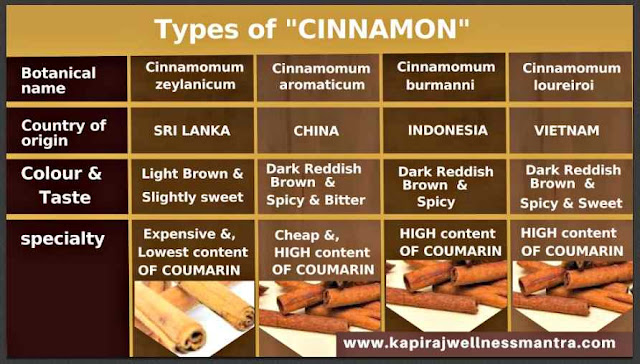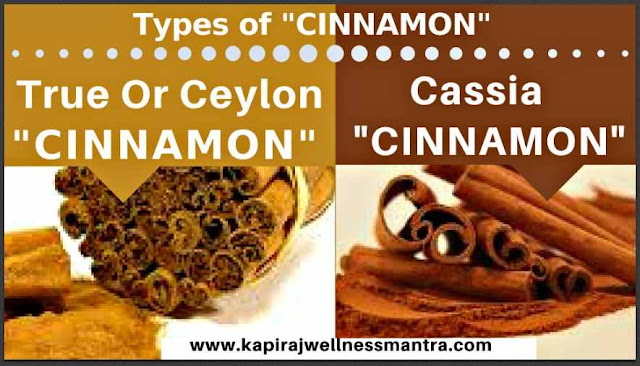Hi Friends
Do you really feel that the “CINNAMON” which you are having in your diet is good for your health?
If you feel so, then I am sorry to say that you may probably wrong. Furthermore, it can prove to be toxic in high doses.
But we all believe that “CINNAMON” is an amazing herb with countless benefits for our whole body.
“CINNAMON” really possesses amazing health benefit properties and, several pieces of research have also proved that “CINNAMON” may cut the Risk of Heart Disease, Can Improve Sensitivity to the Insulin Hormone, Lowers Blood Sugar Levels, may have Beneficial Effects on Neurodegenerative Diseases etc. naturally and without any side-effects.
But all above-mentioned facts are absolutely true with regard to “True CINNAMON” only.
Do you really feel that the “CINNAMON” which you are having in your diet is good for your health?
If you feel so, then I am sorry to say that you may probably wrong. Furthermore, it can prove to be toxic in high doses.
But we all believe that “CINNAMON” is an amazing herb with countless benefits for our whole body.
Does “ Health benefits of CINNAMON” is a myth?
No, absolutely not“CINNAMON” really possesses amazing health benefit properties and, several pieces of research have also proved that “CINNAMON” may cut the Risk of Heart Disease, Can Improve Sensitivity to the Insulin Hormone, Lowers Blood Sugar Levels, may have Beneficial Effects on Neurodegenerative Diseases etc. naturally and without any side-effects.
But all above-mentioned facts are absolutely true with regard to “True CINNAMON” only.
Now question arises
“True CINNAMON” is also called “Ceylon CINNAMON”.
On the basis of the appearance of the quill (made up by pealing the bark and then rolling it into pipes.), it is possible to differentiate “Ceylon CINNAMON” or “True CINNAMON” from the other types of “CINNAMON”.
But before proceeding further let’s first investigate the types of “CINNAMON”.
“CINNAMON” is an indigenous spice, belonging to the Lauraceae family, and exported as “CINNAMON” quills (made up by pealing the bark and then rolling it into pipes.) from four main countries: Indonesia, China, Vietnam and Sri Lanka.
What is “True CINNAMON”?
“True CINNAMON” is also called “Ceylon CINNAMON”.
On the basis of the appearance of the quill (made up by pealing the bark and then rolling it into pipes.), it is possible to differentiate “Ceylon CINNAMON” or “True CINNAMON” from the other types of “CINNAMON”.
But before proceeding further let’s first investigate the types of “CINNAMON”.
Types of “CINNAMON”:
“CINNAMON” is an indigenous spice, belonging to the Lauraceae family, and exported as “CINNAMON” quills (made up by pealing the bark and then rolling it into pipes.) from four main countries: Indonesia, China, Vietnam and Sri Lanka.
 |
| Types of CINNAMON |
On the basis of its country of origin “CINNAMON” is mainly of four types viz.
1.Cassia CINNAMON or Chinese CINNAMON (Botanical NAme:Cinnamomum aromaticum).
2.True CINNAMON or Ceylon CINNAMON
1.Cassia CINNAMON or Chinese CINNAMON (Botanical NAme:Cinnamomum aromaticum).
2.True CINNAMON or Ceylon CINNAMON
(Botanical Name:Cinnamomum zeylanicum)
3.Indonesian CINNAMON
3.Indonesian CINNAMON
(Botanical Name:Cinnamomum burmanni)
4.Vietnamese CINNAMON
4.Vietnamese CINNAMON
(Botanical Name:Cinnamomum loureiroi)
But in general “CINNAMON” is classified into two broad categories such as:
But in general “CINNAMON” is classified into two broad categories such as:
 |
| Difference between Cassia & Ceylon CINNAMON |
1. True CINNAMON or Ceylon CINNAMON;
2. Cassia CINNAMON or Chinese CINNAMON;
Out of these categories
“True CINNAMON” is most expensive and hard to find. It is softer and lighter (light brown) in color and rolled in layers whereas the others are darker, hard, and hollow and rolled in only one layer.
Even though "True CINNAMON" is very expensive, but it is most preferred due to its “ultra-low COUMARIN levels” and the mild delicate taste.
"Cassia CINNAMON" is very cheap with respect to “True CINNAMON” and very easily available in your nearby grocery stores and shop. It is hard and dark (reddish brown) in color, hollow (rolled in an only single layer) in appearance.
It contains a very high level of “COUMARIN” with respect to “True CINNAMON”.
Note: “Cassia CINNAMON” contains up to 1% “COUMARIN”, whereas “True CINNAMON” contains only a trace, about 0.004%;
It is found in a wide variety of plants such as; Tonka bean, vanilla, Woodruff, etc.
But the main source of “COUMARIN” in the human diet is “Cassia CINNAMON”.
“COUMARIN” is considered as a secondary phytochemical with hepatotoxic and carcinogenic properties. Its addition into food products is prohibited because it can prove to be toxic in high doses.
Recent studies report a connection of “COUMARIN” with liver tumors in rats and mice and with Clara cell toxicity and lung tumors in mice.
But ‘COUMARIN free True CINNAMON” has been widely employed and preferred in the treatment and prevention of disease because of its amazing health-promoting properties with no toxicity to the liver and kidneys.
Toxicity might, however, be an issue related to “Cassia CINNAMON” due to its high “COUMARIN” level.
According to the study published in the journal of National Center for Biotechnology Information (NCBI) that the “Ceylon CINNAMON” also contains antioxidant compounds called proanthocyanidins and these are similar to the antioxidant compounds found in green tea and grapes.
So it is probably OK to use a small amount of “Cassia CINNAMON” occasionally. But if you are a daily user or wants to use “CINNAMON” as medicine then, it pays to seek out “True CINNAMON” or “Ceylon CINNAMON”.
So use “COUMARIN free True CINNAMON” and enjoy the amazing health benefits of “CINNAMON” without any side effects.
If you have unlabeled, whole cinnamon sticks, you can easily differentiate “True CINNAMON”, because the rolled bark or quills of “Ceylon CINNAMON” will be thinner and multilayered as compared to the thicker bark of “Cassia CINNAMON.
If you have any query or suggestion you can write it in the comment section or at prajsanjivani@gmail.com.
Thanks
Ms. P Rajeshwari
(Aromatherapist)
Diet & Beauty Consultant
2. Cassia CINNAMON or Chinese CINNAMON;
Out of these categories
“True CINNAMON” is most expensive and hard to find. It is softer and lighter (light brown) in color and rolled in layers whereas the others are darker, hard, and hollow and rolled in only one layer.
Even though "True CINNAMON" is very expensive, but it is most preferred due to its “ultra-low COUMARIN levels” and the mild delicate taste.
"Cassia CINNAMON" is very cheap with respect to “True CINNAMON” and very easily available in your nearby grocery stores and shop. It is hard and dark (reddish brown) in color, hollow (rolled in an only single layer) in appearance.
It contains a very high level of “COUMARIN” with respect to “True CINNAMON”.
Note: “Cassia CINNAMON” contains up to 1% “COUMARIN”, whereas “True CINNAMON” contains only a trace, about 0.004%;
What is “COUMARIN”:
“COUMARIN” (benzo-α-pyrone) is a naturally occurring substance and can be made synthetically as well, that acts as a blood thinner. It has a pleasant sweet odor and bitter taste, pleasant flavor.It is found in a wide variety of plants such as; Tonka bean, vanilla, Woodruff, etc.
But the main source of “COUMARIN” in the human diet is “Cassia CINNAMON”.
“COUMARIN” is considered as a secondary phytochemical with hepatotoxic and carcinogenic properties. Its addition into food products is prohibited because it can prove to be toxic in high doses.
Recent studies report a connection of “COUMARIN” with liver tumors in rats and mice and with Clara cell toxicity and lung tumors in mice.
Tolerable Daily Intake (TDI) of “COUMARIN”:
In 2004, the European Food Safety Authority (EFSA) recommended a “COUMARIN” daily intake limit of 0–0.1 mg·kg−1body weight per day, which means 5.0 mg/day for an adult weighing 50 kg when calculated as 0.1 mg/kg body weight.
Note: One teaspoon of cassia cinnamon powder, therefore, contains 5.8 to 12.1 mg of “COUMARIN”, which may be above the tolerable daily intake value for smaller individuals.The bottom line for the use of “CINNAMON”
Both types of “CINNAMON” (True & Cassia) have been studied for their health benefits.But ‘COUMARIN free True CINNAMON” has been widely employed and preferred in the treatment and prevention of disease because of its amazing health-promoting properties with no toxicity to the liver and kidneys.
Toxicity might, however, be an issue related to “Cassia CINNAMON” due to its high “COUMARIN” level.
According to the study published in the journal of National Center for Biotechnology Information (NCBI) that the “Ceylon CINNAMON” also contains antioxidant compounds called proanthocyanidins and these are similar to the antioxidant compounds found in green tea and grapes.
CONCLUSION:
From the above discussion, we can conclude that the compound “COUMARIN” plays a most significant role in the discrimination of “True CINNAMON” and “Cassia CINNAMON”. Food Authorities have also recommended the tolerable daily intake (TDI) of compound “COUMARIN” (0.1 mg·kg−1body weight per day).So it is probably OK to use a small amount of “Cassia CINNAMON” occasionally. But if you are a daily user or wants to use “CINNAMON” as medicine then, it pays to seek out “True CINNAMON” or “Ceylon CINNAMON”.
So use “COUMARIN free True CINNAMON” and enjoy the amazing health benefits of “CINNAMON” without any side effects.
If you have unlabeled, whole cinnamon sticks, you can easily differentiate “True CINNAMON”, because the rolled bark or quills of “Ceylon CINNAMON” will be thinner and multilayered as compared to the thicker bark of “Cassia CINNAMON.
If you have any query or suggestion you can write it in the comment section or at prajsanjivani@gmail.com.
Thanks
Ms. P Rajeshwari
(Aromatherapist)
Diet & Beauty Consultant






Dear Pooja I loved the benefits highlighted for the cinnamon spice and enlightened with the immense benefits it carries .. I shall certainly put it to use .. also appreciate your endeavour to make us aware of nature offerings . Thank you
ReplyDeleteSujata Sardar Pune